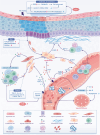Oral submucous fibrosis: pathogenesis and therapeutic approaches
- PMID: 39890798
- PMCID: PMC11785813
- DOI: 10.1038/s41368-024-00344-6
Oral submucous fibrosis: pathogenesis and therapeutic approaches
Abstract
Oral submucous fibrosis (OSF), characterized by excessive deposition of extracellular matrix (ECM) that causes oral mucosal tissue sclerosis, and even cancer transformation, is a chronic, progressive fibrosis disease. However, despite some advancements in recent years, no targeted antifibrotic strategies for OSF have been approved; likely because the complicated mechanisms that initiate and drive fibrosis remain to be determined. In this review, we briefly introduce the epidemiology and etiology of OSF. Then, we highlight how cell-intrinsic changes in significant structural cells can drive fibrotic response by regulating biological behaviors, secretion function, and activation of ECM-producing myofibroblasts. In addition, we also discuss the role of innate and adaptive immune cells and how they contribute to the pathogenesis of OSF. Finally, we summarize strategies to interrupt key mechanisms that cause OSF, including modulation of the ECM, inhibition of inflammation, improvement of vascular disturbance. This review will provide potential routes for developing novel anti-OSF therapeutics.
© 2025. The Author(s).
Conflict of interest statement
Competing interests: The authors declare no competing interests.
Figures



Similar articles
-
Immunopathogenesis of oral submucous fibrosis by chewing the areca nut.J Leukoc Biol. 2022 Feb;111(2):469-476. doi: 10.1002/JLB.3MR0521-763RR. Epub 2021 Jun 14. J Leukoc Biol. 2022. PMID: 34124802 Review.
-
Angiogenesis and Fibrogenesis in Oral Submucous Fibrosis: A Viewpoint.J Contemp Dent Pract. 2018 Feb 1;19(2):242-245. doi: 10.5005/jp-journals-10024-2244. J Contemp Dent Pract. 2018. PMID: 29422478 Review.
-
Oral submucous fibrosis in Asian countries.J Oral Pathol Med. 2020 Apr;49(4):294-304. doi: 10.1111/jop.12924. Epub 2019 Jul 16. J Oral Pathol Med. 2020. PMID: 31310693 Review.
-
Pathogenesis of oral submucous fibrosis.J Cancer Res Ther. 2012 Apr-Jun;8(2):199-203. doi: 10.4103/0973-1482.98970. J Cancer Res Ther. 2012. PMID: 22842361 Review.
-
Fibrotic Matrix Induces Mesenchymal Transformation of Epithelial Cells in Oral Submucous Fibrosis.Am J Pathol. 2023 Sep;193(9):1208-1222. doi: 10.1016/j.ajpath.2023.05.014. Epub 2023 Jun 14. Am J Pathol. 2023. PMID: 37328100
Cited by
-
Molecular Genomics of Oral Submucous Fibrosis: A Narrative Review.Genes (Basel). 2025 May 22;16(6):612. doi: 10.3390/genes16060612. Genes (Basel). 2025. PMID: 40565504 Free PMC article. Review.
-
NRF2 modulates WNT signaling pathway to enhance photodynamic therapy resistance in oral leukoplakia.EMBO Mol Med. 2025 Jul;17(7):1794-1824. doi: 10.1038/s44321-025-00256-w. Epub 2025 Jun 10. EMBO Mol Med. 2025. PMID: 40494896 Free PMC article.
-
Probiotics and prebiotics: new treatment strategies for oral potentially malignant disorders and gastrointestinal precancerous lesions.NPJ Biofilms Microbiomes. 2025 Apr 8;11(1):55. doi: 10.1038/s41522-025-00688-9. NPJ Biofilms Microbiomes. 2025. PMID: 40199865 Free PMC article. Review.
-
Fibulin-4 expression in potentially malignant disorders and squamous cell carcinoma of oral mucosa-An immunohistochemical study.J Oral Maxillofac Pathol. 2025 Apr-Jun;29(2):248-253. doi: 10.4103/jomfp.jomfp_35_25. Epub 2025 Jun 30. J Oral Maxillofac Pathol. 2025. PMID: 40703825 Free PMC article.
-
Induction and characterization of oral submucous fibrosis model with different pathological stages in rats and mice.Sci Rep. 2025 Aug 24;15(1):31128. doi: 10.1038/s41598-025-16715-w. Sci Rep. 2025. PMID: 40850993 Free PMC article.
References
-
- Warnakulasuriya, S. et al. Oral potentially malignant disorders: a consensus report from an international seminar on nomenclature and classification, convened by the WHO Collaborating Centre for Oral Cancer. Oral. Dis.27, 1862–1880 (2021). - PubMed
-
- Sirsat, S. M. et al. Submucous fibrosis of the palate in diet-preconditioned Wistar rats. Induction by local painting of capsaicin-an optical and electron microscopic study. Arch. Pathol.70, 171–179 (1960). - PubMed
-
- Pindborg, J. J. et al. Frequency of oral carcinoma, leukoplakia, leukokeratosis, leukoedema, submucous fibrosis, and lichen planus in 10,000 Indians in Lucknow, Uttar Pradesh, India; preliminary report. J. Dent. Res.44, 61 (1965). - PubMed
Publication types
MeSH terms
Grants and funding
LinkOut - more resources
Full Text Sources

